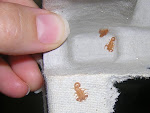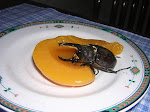Last weekend marked International Migratory Bird day. IMBD is celebrated by federal and state Fish and Wildlife agencies, non-profits, and citizens as a way of highlighting the unique and ever-changing challenges faced by birds migrating to and from their wintering (Central and South America) and breeding (North America) grounds. Challenges migratory birds face include :
- the exotic pet trade
- pesticides (a recent example at bootstrap analysis blog)
- introduced and invasive species (including snakes, feral and domestic cats, rats, and non-native birds which can displace our native ones)
- and the biggy: habitat loss and degradation
- Create backyard habitat -- even modest shrubs, hedgerows, etc., create food sources, shelter, and nesting substrate; find out who your native visitors are and put up a bird box appropriate for them; provide water (change it out twice weekly, and give it a wipe down a few times monthly); provide bird seed.
- Buy shade-grown coffee. A comprehensive blog dedicated to this topic already exists: Coffee & Conservation.
- Keep your kitties inside (all the time), and contribute to spaying/neutering of homeless kitties (stray umbers are at an all-time urban high).
- Contribute as a citizen scientist. It's easy to get involved in the Great Backyard Bird Count (you needn't be an "expert"), the Christmas Bird Count, or Breeding Bird Count. Volunteer an afternoon at a local refuge or bird conservation area with habitat restoration and enhancement projects, or simply donate your old binoculars to your local Audubon chapter.
The Cliff swallows were quite entertaining. The feeding parents looked "frazzled" as parents of demanding young do. I tried to track a few from their nest through the aerial loop-de-loops and back again... Forget it. They are just too quick. One was nice enough to pause for me just before exiting the nest, though.

The prickly pear cactus are in bloom. It was nice to see these bursts of orange just as the Mexican poppies are winding down throughout the Sonoran desert. It doesn't have to be all about the birds, after all...

A Great egret perched in a tree on the River's edge wrapped up the morning nicely. Egrets embody citizen activism and conservation that dates back more than 100 years to the advent of the Audubon Society. A brief explanation: in the late 1800's Great egrets were one of many birds threatened by prolific market hunting for their snowy-white plumes, used in lady's hats. A group of forward-thinking society ladies in Boston, essentially disgusted and concerned about the trend, launched the first Audubon chapter (see Hats off to Audubon, Audubon Magazine, 12/2004).
The egret is the prominent logo of the National Audubon Society to this day. Each time I see one, I am reminded of the power of citizen conservationists.


+reduced.jpg)


No comments:
Post a Comment